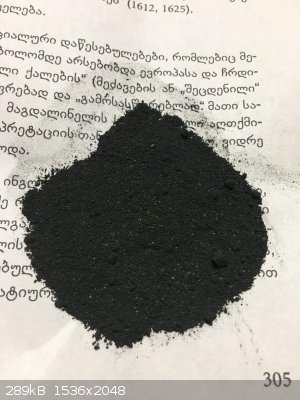vano
National Hazard
   
Posts: 661
Registered: 22-3-2019
Location: Georgia
Member Is Offline
|
|
Microporous zinc + photo
All of you have seen the reaction between zinc and hydrochloric acid. This is very fast and exothermic reaction. If you observe this reaction a small
amount of black powder is formed, which does not dissolve in acid during the reaction. I filtered it and saved it with each reaction. The photo shows
that it is black, but actually it is gray powder. White particles are zinc oxide, of course it is pyrogenic and when I heated it, an oxide was formed.
Surprising though it is quite an inert powder. I conducted various experiments with acids and bases. It does not dissolve in cold acids. Dissolves in
warm nitric acid and warm sodium hydroxide solution.With the latter formed a precipitate of cadmium oxide color, which I do not know what it is.
• I almost forgot. It is formed when hydrogen released during a reaction dissolves on the surface of zinc. Unfortunately I do not have a microscope
otherwise I would be happy to observe the pores.
• My plan is to mix palladium and see how effective the catalyst will be. Of course it is not as inert as activated carbon, although we know that
calcium carbonate is used instead of carbon.

|
|
|
woelen
Super Administrator
        
Posts: 7977
Registered: 20-8-2005
Location: Netherlands
Member Is Offline
Mood: interested
|
|
You collected quite a lot of this powder! I always thought that the black remains are carbon impurities of the metal, but if heating it leaves behind
ZnO, then it must be zinc in another form (or maybe zinc, with some hydrogen dissolved in it?).
|
|
|
vano
National Hazard
   
Posts: 661
Registered: 22-3-2019
Location: Georgia
Member Is Offline
|
|
Quote: Originally posted by woelen  | | You collected quite a lot of this powder! I always thought that the black remains are carbon impurities of the metal, but if heating it leaves behind
ZnO, then it must be zinc in another form (or maybe zinc, with some hydrogen dissolved in it?). |
It is 100% zinc. A have pure hydrochloric acid and zinc and it is unlikely to be any impurities. It isnt another form It is ordinary zinc it just has
deep pores and has a dark color due to light reflection. As I remember the color is determined by the angles in the pores. The light is also reflected
in the pores and after some time it comes out.
I have one question. what the number of stars depends on?
|
|
|
Opylation
Hazard to Others
  
Posts: 131
Registered: 30-8-2019
Member Is Offline
|
|
I believe it is directly related to the number of posts you make.
That is really interesting that the left over black powder is zinc. I always thought, like woelen, it was carbon impurities, just like when you
dissolve nails or any other steel in HCl and get black precipitate are the bottom. I will have to start collecting the remains of zinc reductions.
|
|
|
vano
National Hazard
   
Posts: 661
Registered: 22-3-2019
Location: Georgia
Member Is Offline
|
|
Quote: Originally posted by Opylation  |
I believe it is directly related to the number of posts you make.
That is really interesting that the left over black powder is zinc. I always thought, like woelen, it was carbon impurities, just like when you
dissolve nails or any other steel in HCl and get black precipitate are the bottom. I will have to start collecting the remains of zinc reductions.
|
Thank you. It will be good if you collect. I used almost one liter of concentrated hydrochloric acid to get this. Do not overheat during drying,
otherwise it will burn.
|
|
|